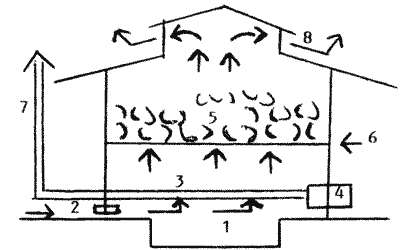
THE 3 Cs OF PAPUA NEW GUINEA
COFFEE
A bucket full of red coffee berries on the tasting table probably inspired Alf to commence his unprepared talk about coffee in Papua New Guinea. There are two main varieties grown; the lowland coffee, Robusta, and the highland coffee, Arabica.
The coffee culture started in Goroka and extended quickly to the surrounds of Mount Hagen.
It takes 2-4 years for the coffee bush to come into production. The red ripe berries are still hand-picked and taken to the factory for further treatment.
After pulping, to get rid of the skin, the beans were fermented for 3-4 days, depending on the weather and quantity.
Drying was done in the sun on concrete floors with sliding roofs to protect it from rain. More advanced factories are using mechanical drying methods.
The last handling is the removal of the parchment. The grading was done manually before the grading machines came in.
COCOA
Both crops, cocoa and coffee were planted under light shade. The main trees for that purpose were Leucaena glauca and Albizia falcataria, though the optimum shade was given by the coconut tree. Some coconut plantations had cocoa interplanted as their second crop. The cocoa fruit/pod comes in a great variety of colours due to the slight variations you get with seedlings.
When interplanted with coconut, three seeds were planted and only the best and strongest seedling was maintained.
Harvesting was done by hand. The pods were broken, the seeds and mucus were taken out.
Fermenting was the next step. The standard fermenting boxes were 1200 x 1200 x 1200 mm, in a series of four. The beans/mucus were put in the first box and covered with banana leaves. The heat generated during the fermenting could reach high temperatures. After 24 hours the content of the first box was emptied and put in the second box, while the first box got a new load. The same procedure was repeated till the last box was emptied.
Like coffee, the beans were then dried on concrete floors with sliding roofs. During drying, women were busy picking out the bad beans and other dirt. After grading, the beans were sold.
COCONUT
In 1800, Alf's grandfather started the first commercial coconut plantation at Talum and Gunantambu in the Kopoko district of New Britain - PNG. The estate was called Kuradui, after the Kura tree which grew there in abundance.
The best way to plant coconuts is to have the nuts sprout first on the ground, select the strongest growers and plant them at a depth of roughly one coconut.
The tree bears at 6 years, but the commercial crop starts at 8-10 years. Harvesting was done by simply collecting the ripe fallen nuts.
To make copra - the trade name of dried coconut - there were four methods in use:
1. Hot-air
2. Ceylon dried
3. Smoke
4. Sun
1. Hot-air
The coconut was split in half by axe The kernel was scooped out with a special copra-knife. The green copra was then put in a hot-drier. For hot drying, you need a fire box or kiln, fitted with flues which were heated up. The cold air from underneath was heated up this way and the hot air then dried the copra. The hot air then left the kiln via the "open" jackroof. The process lasted 3-4 days. Perfectly dried copra should snap open cleanly and leave no white line in the kernel to show moisture.
The copra is then packed and sold in 4 bushel bags.
HOT-AIR METHOD |  |
2. Ceylon dried
Same as hot-air drying, but the nuts were husked in the field and nuts were broken in half. An experienced husker could husk a nut in two seconds.
Ceylon driers have four distinct pits and bays. Split nuts were placed face down over the pit and heated with the fire of plain coconut shells. This gives a hot, smokeless fire. After four days of drying, the copra was ready to be taken out of the shells and bagged. The shells were used to fire the next load and no additional firewood was used. These days, one would say, "an environment-friendly kiln!"
3. Smoke
Beds of green copra were built over a huge pit under a roof. Again, husks and shells were used to fire the pit for three days. This method gives a lower grade copra.
4. Sun dried
Mainly done by locals in small amounts by turning the copra regularly. It is a rather time-consuming and labour-intensive way, but it makes top-quality copra.
DATE: September 1993
* * * * * * * * * * * * *
